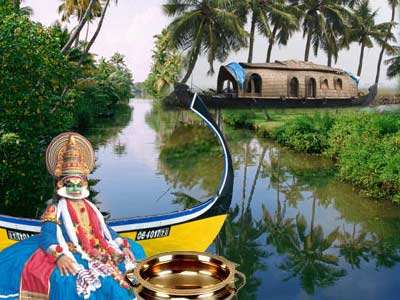Kerala Tourism
The name Kerala is derived from the term 'Kera' which means coconut. The ancient legend claims that Kerala is the landmass created and gifted by Lord Parasurama when he threw his battle axe into the sea. Kerala consists of fourteen districts, with Thiruvananthapuram as its Capital.
Kerala continues to be a primary source of spices such as ginger, cinnamon, cardamom and pepper as well as ivory and teak. Often referred to as 'God's own country', Kerala is a fertile strip of land that lies on the southwest coast of India.
Kerala tourism has come into its own as Kerala has become an international tourist destination, for those seeking the idyllic backwaters, magnificent hill stations or ayurvedic relief from stress.
KERALA TRAVEL
Kerala is one of the fastest growing tourist destinations in Asia, with pristine hill stations, grasslands that roll down the hilly spots, paddy fields, tea and coffee plantations, wildlife sanctuaries and glistening brooks and vast expanse of backwaters and lakes. A traveler to Kerala is sure to be lost amidst the serene environs of the backwaters and hillstations, rejuvenated with 'Ayurveda' or cruising on a palm fringed country boat and experiencing the many faces of this wonderful land that embraces ones body and soul.
Kerala Tour
The discerning tourist has a host of landmarks to visit. From monuments, palaces, forts, memorials and places of worship to pilgrim centers and festivals that portray the cultural mosaic, Kerala leaves an indelible impression on the mind of the tourist.
Backwaters of Kerala
Kerala has a number of backwaters, canals, lagoons, lakes and rivers, which are a major tourist attraction. The palm fringed tranquil backwaters were once the State's trade highways. Journeying across the backwaters can be one of the most memorable and unique experiences for tourists to Kerala. There are shallow palm fringed boats to travel across the backwaters.
- Kuttanad region which is called the rice bowl of Kerala
- Vembanad Lake reputed for Kumarakom backwaters, which is the largest backwater stretch
- Ashtamudi Lake that has eight arms covering a major portion of Kollam district Alappuzha, which is one of the major centers for backwater boat trips.
Wildlife sanctuaries: Kerala has several prominent wildlife sanctuaries. Some of them are Thekkady in Idukki, Parambikulam in Palakkad and Sultan Bathery in Waynad district. The Periyar National Park is one of the best wildlife sanctuaries in Kerala.
The forests of Periyar Reserve, Chinnar Wild life sanctuary are famous for elephants, gaur, deer and occasionally tiger, leopard and panther. For the bird watcher, Kerala is a dream destination with over five hundred species of birds.
The Kumarkom bird sanctuary, Periyar tiger reserve, Thattekad bird sanctuary, and the Waynad hills are home to several migrant and local birds.
Water Sports: A tourist to Kerala can enjoy catamaran sailing, wind surfing, kanaking, canoeing, scuba diving and snorkeling and para sailing.
Art and Culture: Kerala has a fascinating heritage of dance. The world's oldest martial art 'Kalarippayuttu' is from Kerala. 'Kathakali' which is a rhythmic dance is well known Mohiniyattam is a solo dance that combines the graceful elegance of bharathanatyam and the vigor and dynamism of Kathakali. Koothu, Koodiyattam, and Ottamthullal are other famous dances native of Kerala.
Ayurveda: The term Ayurveda is derived from the Sanskrit words Ayur, which means life and Veda, which means knowledge. Ayurveda, a medical system over 5000 year old, thrives in Kerala because of the equable climate, wealth of herbs and medicinal plants that grows in natural abundance in Kerala on the Western Ghats and the cool monsoon season. There are many centers in Kerala offering a range of curative and restorative packages.
Boat races in Kerala
The boat races are of legendary importance in Kerala. The season of Onam is exemplified by the boat races. The Aranmula Vallamkali is the traditional boat race conducted at Sri Parthasarathy temple in connection with Onam celebrations.
The Champakulam boat race has spectacular water floats, decorated boats and the Vanchipattu which is the folk song of the oarsmen and the Chundanvollom that is a snake boat over 100 feet in length are the highlights.
The Indira Gandhi Boat Race is conducted on backwaters of Cochin. Over sixteen snake boats participate in this scintillating event.
The Nehru Trophy boat race is the greatest event on the backwaters of Kerala held on the second Saturday of August every year. Magnificent snake boats compete for the prestigious trophy instituted by Pundit Jawaharlal Nehru.
The Rajiv Gandhi Boat Race is in memory of the former Prime Minister Sri Rajiv Gandhi. Colorful procession, boat races and water floats highlights this occasion.
Hill Stations in Kerala: Kerala has several exotic hill stations especially on the Western Ghats.
- The Chembra Peak, the highest one in Waynad at 2100 m above sea level
- Chithirapuram with its sleepy cottages and old courts that still exudes old world charm.
- Devikulam an idyllic hill station about 7 kms from Munnar known for its cool mountain ranges and picturesque surroundings
- Munnar which is situated in the confluence of the three mountain streams, above 1600 m above sea level.
Festivals of Kerala
Onam is the annual harvest festival native of Kerala. Celebrations for Onam go on for ten days with floral decorations, elephant processions, classical folk dances, cultural pageants and water carnivals adding up to the festivity. Thrissur Pooram is held at Thekindadu Maidan in the month of May.
The Makaravilakku is conducted at Sri Dharmasastha temple at Sabarimala. It is one of the few occasions when the temple is open to the public every year.
There are special devotional rites conducted and thousands of pilgrims gather to witness the event on the evening of 'makara sankaranthi' when the makara vilakku or the light of kakara is believed to be seen on the eastern horizon.
The Maramom convention is a large gathering of Christians in Asia that happens at Pathanamthitta about 16 kms from Thiruvalla on the banks of the river Pamba in February.
|


























































































